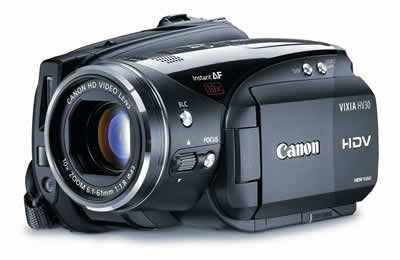
Last week Canon announced the Vixia HV30, the newest high def camcorder designed to replace older Canon HV20. I have been itching to make the jump to HD video for the past year. I held off largely because my standard definition Canon GL2 was still serving me well. In addition, the HD standards and industry trends were still in flux so I was kinda gun shy about making a major purchase during times of technological uncertainty. You have to understand that for me, nothing is as frustrating as having your new camcorder becoming obsolete the week after you purchase it.
Anyway, I was all set to order my camera right before Christmas. Luckily I decided to wait a few weeks and see what new tech tools were going to be announced at the Consumer Electronics Show (CES), and wouldn’t you know, Canon decided to announce the upgrade to their consumer HD line. Before the HV30 was announced, I was all set to buy the Canon HV20. The HV20 is one of the entry level HD camcorders in the Canon lineup. It is a single chip tape based unit that has gotten rave reviews for it’s images quality. Despite the strong consumer reports on the performance of the HV20, the upcoming release of the new HV30 made me pause and take stock of what I really wanted in a entry level HD camcorder.
Initially I wanted a hard drive based HD camcorder because I hate lugging tapes around. However I quickly decided against this and opted for a more traditional tape based system. This was largely due to reading many of the problems that video editors are having with capturing footage using the AVCHD format common to hard drive based HD camcorders. When combined with the fact that hard drives eventually fail and that tape based systems inherently offer archival to mini dv tapes, a tape based system seems to be the best option at this time. At least until the problems with the AVCHD format is resolved or replaced by another format.
Also I wanted a camera in the sub $1000 buck range so I knew that I was only going to be looking at the single CCD HD camcorders. I am eager to get a 3 CCD HD camera to match my standard def GL2, however spending at least $3000 bucks on a new camera was not an option for me right now. Especially since my GL2 is still fine for nearly all of the web and DVD productions that I am currently shooting. If I am really honest about it, an HD video camera is a luxury for me and not a necessity.
Finally, I have always be kinda of partial to the Canon camcorders. I have owned a few of them and was always pleased with their performance. While I am aware that many of their mini-dv cameras have had issues with some tape loading mechanism, I haven’t encountered any of those problems with any of the cameras I have owned. So when I added up all of the things I was looking for the only options came down to the Canon HV20 and HV30.
The HV30 adds some modest, but yet extremely cool, feature upgrades to the previous HV20 line. In addition to a new sleek all black body and a improved zoom toggle, the HV30 now has an option to shoot in 30P while retaining the HV20’s ability to capture footage in 60i and 24P. Canon states that the 30p feature will mostly appeal to online video content creators since many video sharing sites like YouTube down-convert the frame rate to 15fps. This can lead to a choppy image quality if footage is shot at frame rates like 30p which can’t be neatly halved to 15fps. Since much of the video content that I create will wind up on the web, the 30p was an exciting upgrade. But I really didn’t need the 30p for web delivery since I have a number of software solutions that can effectively convert my footage to a more managable frame rate. Granted this will take extra time to output my productions. However anyone that knows anything about college professors will tell you that we have more time than money.
The HV20 is currently selling for about $680 on Amazon.com. This is over 300 bucks cheaper than the $999 hit that Canon is listing as the retail price for the HV30. While I suspect that the price on the HV30 will drop sharply after the initial release, especially in the NYC area, the $300 price difference is a big deal for me considering the minor improvements over the HV20. The 30p mode would be great for the web productions that I create and the black color is much cooler, but I still don’t know if that justifies the extra 300 bucks. So once again I am back on the fence.
I plan on waiting until the HV30 is actually released in late February or early March before pulling the trigger. I want to see if the price drops a bit and if the camera lives up to the hype. So all in all, I am glad that I decided to wait a lttle longer. My only real regret about the situation was that I didn’t plan our recent family vacation to Las Vegas to coincide with the CES trade show. It would have been great to have seen the new equipment firsthand. Ah well, there is always next year.

